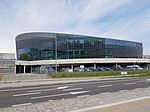Gliwice Cathedral

The Sts. Peter and Paul Cathedral (Polish: Katedra św. Apostołów Piotra i Pawła) also called Gliwice Cathedral is the name given to a Catholic church that serves as the cathedral of Gliwice, in the central district of this city of Poland.The church was built between 1896 and 1900 and was initially a subsidiary of the parish church of All Saints. In 1908 the parish of St. Peter and Paul was erected, and its first parish priest was Monsignor Józef Jagło. Its bells were confiscated in 1917 during the First World War. Between 1934 and 1936 it was renovated and repaired. In January 1945 he suffered by the Soviet bombardment of German positions during World War II, damages would be repaired soon after (1945–1946). Local authorities renewed the structure for the last time in 2009. In 1992, Pope John Paul II erected the Diocese of Gliwice, and the parish church of St. Peter and Paul was elevated to the dignity of the cathedral.
Excerpt from the Wikipedia article Gliwice Cathedral (License: CC BY-SA 3.0, Authors, Images).Gliwice Cathedral
Księcia Ziemowita, Gliwice
Geographical coordinates (GPS) Address External links Nearby Places Show on map
Geographical coordinates (GPS)
| Latitude | Longitude |
|---|---|
| N 50.2913 ° | E 18.6655 ° |
Address
Katedra Świętych Apostołów Piotra i Pawła
Księcia Ziemowita
44-100 Gliwice (Śródmieście)
Poland
Open on Google Maps










